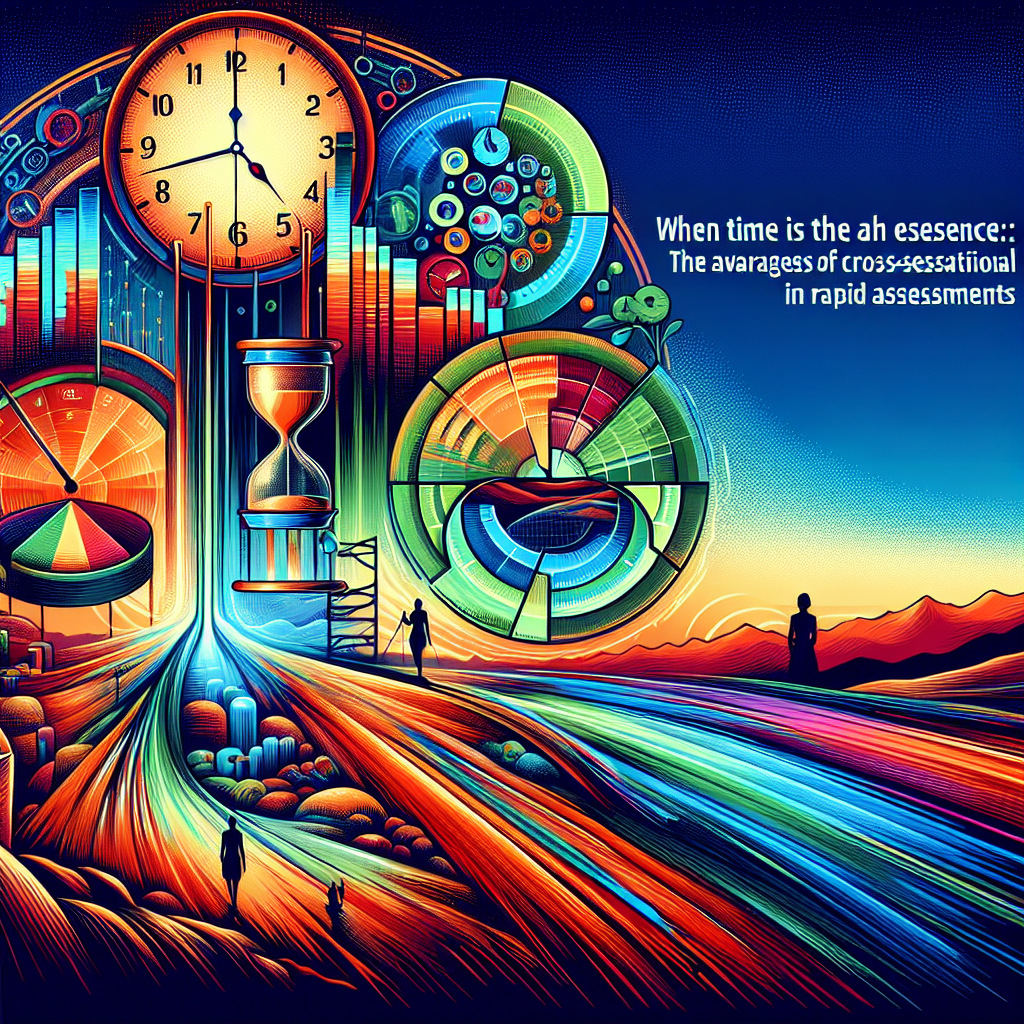
Introduction
In today’s fast-paced world, decisions often need to be made almost instantaneously. In sectors such as healthcare, marketing, and policy-making, quick and accurate assessments can significantly influence outcomes. This urgency emphasizes one crucial aspect of research design: the necessity for speed without sacrificing utility. When time is of the essence, cross-sectional research stands out as a vital tool.
This article will explore When Time is of the Essence: The Advantages of Cross-Sectional Research in Rapid Assessments. We will delve into why this method is both effective and efficient, backed by real-world examples and insights that highlight its relevance in various fields.
Understanding Cross-Sectional Research
What is Cross-Sectional Research?
Cross-sectional research is a study design that captures information at a single point in time. This technique allows researchers to analyze data from a specific subset or population, providing a snapshot of variables and their relationships without the need for longitudinal tracking.
The Process of Cross-Sectional Research
- Identifying the Population: Define the group or community you are interested in analyzing.
- Sampling: Choose a representative sample that reflects the population.
- Data Collection: Gather data using surveys, interviews, or existing databases.
- Analysis and Reporting: Analyze the data to derive useful insights, which can be reported as findings.
This streamlined approach is particularly useful when rapid assessments are necessary, offering data quickly while requiring less resources than other methodologies.
Advantages of Cross-Sectional Research
1. Speed and Efficiency
When Time is of the Essence: The Advantages of Cross-Sectional Research in Rapid Assessments shines in situations where immediate data is essential. For instance, during public health emergencies, swift assessments can aid in understanding the spread of diseases. In the 2014 Ebola outbreak, cross-sectional studies were rapidly deployed to ascertain transmission rates, informing containment strategies almost in real-time.
Case Study: Ebola Response
- Context: During the Ebola outbreak in West Africa, health officials needed to assess the virus’s spread quickly.
- Application: Cross-sectional studies allowed researchers to rapidly gather data on infection rates and demographic factors influencing the epidemic, informing effective responses.
- Outcome: The swift insights derived from these studies contributed to targeted public health interventions, demonstrating the efficacy of this research method.
2. Cost-Effectiveness
Another pertinent advantage is the cost-effectiveness of cross-sectional research. Compared to longitudinal studies, which require extensive time and financial investment, cross-sectional assessments can often be executed with fewer costs.
Table: Cost Comparison of Research Methods
| Research Method | Duration | Cost | Resource Requirement |
|---|---|---|---|
| Cross-Sectional | Short | Low | Low |
| Longitudinal | Long | High | High |
| Qualitative Studies | Variable | Moderate | Moderate |
This table highlights the comparative advantages of cross-sectional research, emphasizing its feasibility for organizations with limited resources or those needing immediate results.
3. Versatility Across Various Fields
Cross-sectional research can be applied to different domains, from health to sociology to market research. This versatility is especially crucial in fast-evolving fields like technology, where understanding trends swiftly can drive innovation.
Case Study: Market Research in Tech
- Context: In the rapidly changing tech industry, companies must understand consumer preferences quickly.
- Application: A cross-sectional study can help firms gauge customer satisfaction regarding new products leading up to a launch.
- Outcome: These insights enable companies to make necessary adjustments before publicly releasing products, optimizing market reception.
4. Immediate Insights and Data Visualization
When conducting cross-sectional research, data can be aggregated and presented in real-time, allowing stakeholders to visualize information readily. This immediacy benefits decision-makers who require actionable insights without delay.
Chart: Example of Rapid Data Visualization in Cross-Sectional Research
| Variable | Value Percentage (%) |
|---|---|
| Satisfaction Level | 75% |
| Awareness Level | 60% |
| Engagement Rate | 80% |
This visualization can be utilized in presentations to display real-time public sentiment or engagement metrics effortlessly.
5. Broad Data Capture
Cross-sectional research allows for the comprehensive capture of multiple variables in one study. This breadth can lead to rich datasets that inform numerous facets of a research question, helping to identify patterns and correlations effectively.
Case Study: Social Determinants of Health
- Context: Evaluating the health outcomes of various demographics.
- Application: A cross-sectional approach can capture data on health, income, education, and employment status in one study.
- Outcome: Health policymakers can target interventions more effectively based on holistic insights.
Challenges of Cross-Sectional Research
It is essential to recognize that while the advantages of cross-sectional research are substantial, challenges do exist. One key limitation is the inability to infer causal relationships since data is collected at one point in time. Moreover, cross-sectional studies can sometimes be influenced by bias if the sample isn’t representative.
However, these challenges can often be mitigated through careful planning, mitigating risks, and ensuring thorough sampling methods.
Conclusion
When Time is of the Essence: The Advantages of Cross-Sectional Research in Rapid Assessments cannot be understated. Its speed, cost-effectiveness, versatility, and ability to deliver immediate insights make it an essential tool across various domains. As society increasingly demands prompt responses to pressing issues—from health crises to market trends—understanding the strengths of cross-sectional research is vital.
Actionable Insights
For professionals looking to leverage cross-sectional research effectively:
- Prioritize Clear Objectives: Define what you need to assess before starting the research.
- Focus on Sampling: Ensure that your sample accurately reflects the population for reliable results.
- Utilize Data Visualization: Present data clearly to enhance understanding and facilitate faster decision-making.
By adopting these insights, organizations can harness the full potential of cross-sectional research for impactful rapid assessments.
FAQs
1. What is cross-sectional research?
Cross-sectional research is a study methodology that collects data at one point in time from a selected sample to analyze and observe relationships between variables.
2. What are the primary advantages of cross-sectional studies?
Key advantages include speed, cost-effectiveness, versatility across fields, broad data capture, and immediate insights through data visualization.
3. Can cross-sectional research establish causation?
No, cross-sectional research mainly identifies correlations rather than establishing direct causation due to its design of collecting data at a single point in time.
4. How is cross-sectional research applied in healthcare?
In healthcare, cross-sectional studies quickly assess phenomena such as disease prevalence, health behaviors, or access to care, informing urgent public health decisions.
5. What are common limitations of cross-sectional research?
Common limitations include potential sampling bias, inability to draw causal conclusions, and the snapshot nature of the data, which might miss dynamics over time.
In a world where rapidly changing landscapes demand quick but reliable information, the value of cross-sectional research cannot be overstated. Embrace its advantages, and position yourself and your organization for informed, timely decision-making in critical moments.















